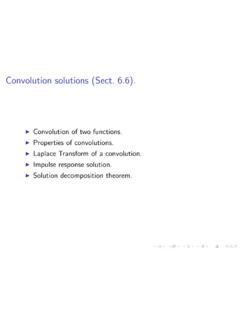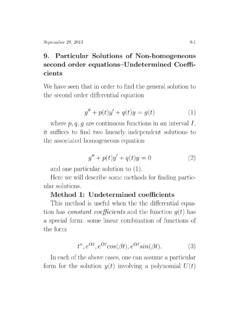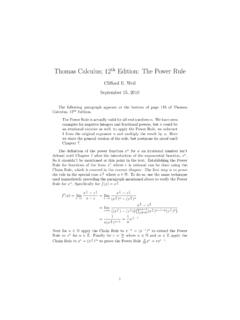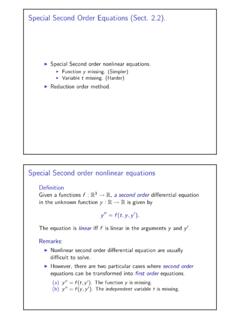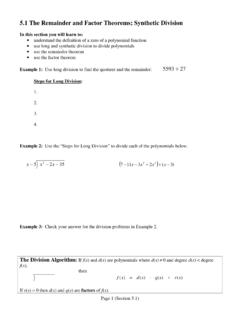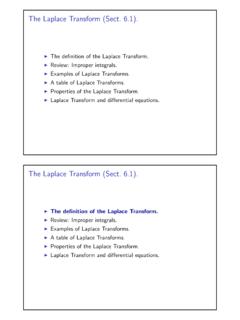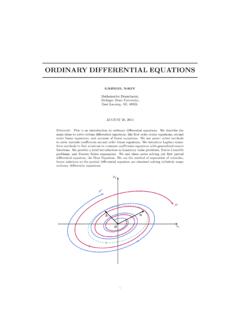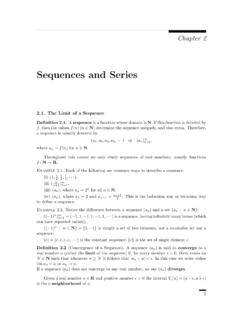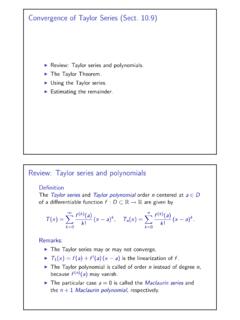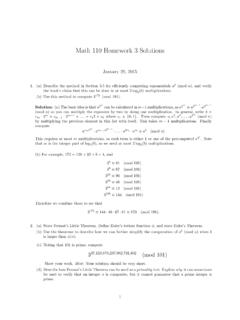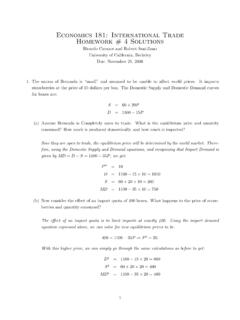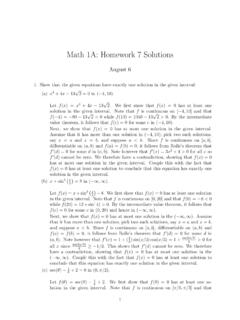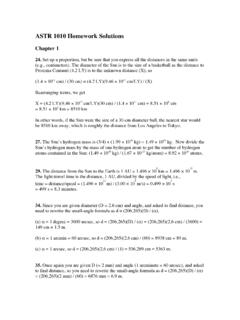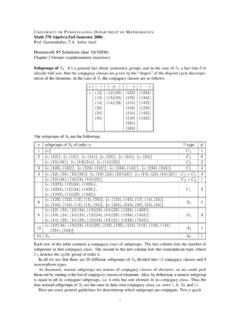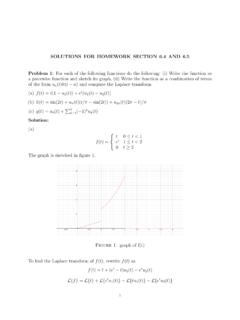Transcription of Solutions to Homework 9 - Michigan State University
1 Solutions to Homework 9 Section # 12: LetDbe the region bounded below by the conez= x2+y2and above by the paraboloidz= 2 x2 y2. Setupintegrals in cylindrical coordinates which compute the volume :The intersection of the paraboloid and the cone is a circle. Sincez= 2 x2 y2= 2 r2andz= x2+y2=r(assumingrisnon-negative), 2 r2=r, which implies thatr2+r 2 = (r+ 2)(r 1) = 0. Sincer 0,r= 1. Therefore,z= 1. So,the intersection of these surfaces is a circle of radius 1 in the planez= 1.(a) UsedV=rdz drd .The cone is the lower bound forzand the paraboloid is the upper boundforz, as is clear from a sketch of the figure. The projection ( theshadow) of the region onto thexy-plane is the circle of radius 1 centered atthe origin. Therefore, DdV= 2 0 10 2 r2rrdz drd .(b) UsedV=rdrdz d .The region is not simple in ther-direction. The lower bound forris zero,but the upper bound is sometimes the conez=rand sometimes theparaboloidz= 2 r2. The planez= 1 dividesDinto twor-simpleregions.
2 Therefore, DdV= 2 0 10 z0rdrdz d + 2 0 21 2 z0rdrdz d .(c) UsedV=rd dz is no restriction on as this region is rotationally ,zis still constrained by the cone and the parabola. Therefore, DdV= 10 2 r2r 2 0rd dz # 18: LetDbe the region enclosed by the cylindersr= cos andr= 2 cos and by the planesz= 0 andz= 3 y. Set up an iteratedintegral which computes Df(r, ,z)dz rdrd .Solution: Since 0 z 3 y, it follows that 0 z 3 rsin incylindrical coordinates. The projection ofDonto thexy-plane is the regionbetween the circles given in polar coordinates byr= cos andr= 2 cos .The first circle is inside the second, and these two circles intersect when = /2, /2. This can be seen from a sketch or by solving the equationcos = 2 cos ; gather like terms to obtain 0 = cos . Therefore, Df(r, ,z)dV= /2 /2 2 cos cos 3 rsin 0f(r, ,z)rdz drd .Note: You cannot double the integral and integtrate over 0 is only permissible if the functionf(r, ,z) is even with respectto the variable.
3 Section # 32:a LetDbe the region bounded below by the conez= x2+y2and above by the planez= 1. Set up triple integrals whichcompute the volume :(a) UsedV= 2sin d d d .If the pointPlies in the regionD, then varying its -coordinate keepsPinsideDso long as 0 sec . The upper bound is determined by theplanez= 1, which has equationz= cos = 1 in spherical coordinates;solving for yields = sec .Ignoring (projecting onto = 1 for instance), one see that the variable varies from 0 to /4. Finally, since the figure is rotationlly symmetric, varies from 0 to 2 . Therefore, DdV= 2 0 /40 sec 0 2sin d d d .(b) UsedV= 2sin d d d .This integral is tricky to set up. IfPlies in the regionD, then varying its -coordinate keepsPinsideDso long as either its distance from the originis less than or equal to one and 0 /4, or its distance from the originis greater than or equal to one and its -coordinate is bounded below bythe restriction thatz= 1 and above by /4. In other words, this region isnot -simple: two integrals are required.
4 For the second integral, theconditionz= 1 implies that cos = 1 so that sec 1 , , then thezcoordinate can vary from 1 to 2; the upper boundis determined by the maximum distance from the origin to a point insidethe regionD, which is realized by a point which lies on the intersection ofthe cone with the planez= above shows that DdV= 2 0 10 /40 2sin d d d + 2 0 21 /4sec 1( ) 2sin d d d .Section # 34: Set up an integral in spherical coordinates whichcomputes the volume of the region bounded below by the hemisphere = 1,z 0, and above by the cardioid of revolution = 1 + cos . Thencompute the value of the : Clearly 1 z 1 + cos . A careful sketch of the figure revealsthat 0 /2. This can also be determined algebraically. The cardioidand the hemisphere meet when 1 = 1 + cos , which implies that cos = , DdV= 2 0 /20 1+cos 1 2sin d d d The innermost integral evaluates to(1 + cos )33sin sin anti-derivative with respect to can be determined for the firstsummand by using the substitutionu= 1 + cos ,du= sin d.
5 Thesecond summand is easy to integrate. Answer: 11 # 2: Solve the systemu=x+ 2y,v=x yin terms ofxandyand compute the Jacobian determinant (x,y)/ (u,v). Then sketch theimage under the transformationT(x,y) = (u,v) of the triangular region inthexy-plane bounded by the linesy= 0,y=x, andx+ 2y= : Solving the system forxandyresults inx= (1/3)(u+ 2v) andy= (1/3)(u v). The transformed region is a triangle bounded by the linev= 0 (which corresponds tox=y), the lineu= 2 (which corresponds tox+ 2y= 2), and the lineu=v(which corresponds toy= 0). TheJacobian determinant is equal to 1 # 4: Solve the systemu= 2x 3y,v= x+yin terms ofxandyand compute the Jacobian determinant (x,y)/ (u,v). Then sketchthe image under the transformationT(x,y) = (u,v) of the parallelogram inthexy-plane with boundary linesx= 3,x= 0,y=x, andy=x+ : Solving the system forxandyresults inx= u 3vandy= u 2v. The transformed region is again a parallelogram. It isbounded by the linev= 0 (corresponding toy=x), the linev= 1(corresponding toy=x+ 1), the lineu+ 3v= 3 (corresponding tox= 3), and the lineu+ 3v= 0 (corresponding tox= 0).
6 The Jacobiandeterminant is equal to # 17: Show that the Jacobian determinant of thetransformation from Cartesian ( , , )-space to Cartesian (x,y,z)-space is 2sin .Solution: The equationsx= sin cos ,y= sin sin , andz= cos define a transformation from ( , , ) into (x,y,z). The Jacobian matrix isequal to sin cos cos cos sin sin sin sin cos sin sin cos cos sin 0 The determinant of the above matrix is most easily computed by using thelast row since one of the terms is equal to zero. The Jacobian determinantis equal tocos cos cos sin sin cos sin sin cos +( 1)( sin ) sin cos sin sin sin sin sin cos From here, evaluate the 2 2 determinants and simplify by gathering termsso as to apply cos2 + sin2 = 1 (twice) and cos2 + sin2 = 1 (once).(Bonus) Compute the determinant of the following square tri-diagonalmatrix assuming that the matrix has has 2012 rows: 1 1 0 1 1 1 1 0 1 110 0 0 Clarification: the matrix has 1 s along each of the middle three diagonals,and 0 s in all other : LetAnbe the tridiagonal matrix withnrows, and letAn(i,j) bethe (i,j) minor.
7 Computing the cofactors of the first row, one obtainsdetAn= detAn(1,1) detAn(1,2) = detAn 1 detAn(1,2)To compute the determinant ofAn(1,2), compute the cofactors of its firstcolumn:detAn(1,2) = detAn 2 Therefore, detAn= detAn 1 detAn 2. Since, detA1= 1, detA2= 0,the sequence{detAn}is forn 1 is equal to the following:1,0, 1, 1,0,1,1,0,..,which is periodic with period of length 6 and one period is equal to1,0, 1, 1,0,1. Since 2012 2 mod 6, one deduces that detA2012= 0.
